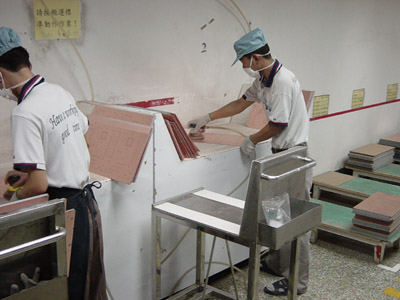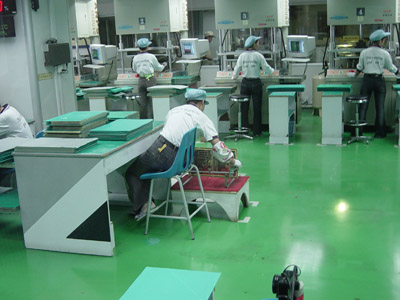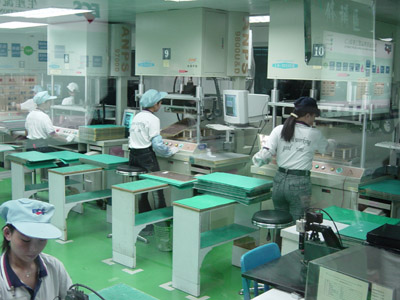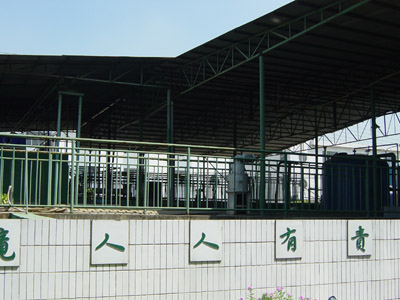Inside Elitegroup Computer Systems: From Taipei to Shen Zhen
by Kristopher Kubicki on October 4, 2003 12:39 PM EST- Posted in
- Motherboards
Biloda PCB: OS Testing and Lithography
Click to enlarge.
Finally, the drilled boards are scrubbed. Up until now, this is the first time we've seen male workers in the factory. In case you are interested in knowing what is on the shirt of the man on the left, it says, "Have a working good time." I emailed Anand if we could get polo shirts with that motto on it, but I did not get a response.
The majority of the small drill holes are filled with the particular solder or copper through chemical lithography. The motherboard circuitry itself is "printed" right on the board using large machines that somewhat resemble Xerox copiers. A negative image of the circuitry is placed over the board, and then a chemical process removes the exposed top layer not covered by the negative. A resulting circuit is produced. Workers flip the board and repeat the process to create a double-sided circuit board.
Click to enlarge.
Now this thing is starting to look more like (two) motherboards! After the board is done printing, it immediately goes across the hall to the OS testing room. The QA on the motherboard line really picks up at this point. These large machines take the motherboards and press a matching circuit design on the top and bottom. A current is passed through and the monitor tells the worker whether or not all electrical paths are correct.
The next (immediate) room contained the print facilities. Although I can't exactly describe what this guy is doing, I believe the process is somewhat similar to silk screening. This particular red dye is being applied over some PC Chips motherboards. One thing that struck us as odd is that there has been a surprising amount of manual labor up to this point. Considering the extremely cheap cost of workforce, it certainly must be cheaper and more effective to use manual labor in a high volatile sector like the motherboard industry. ECS was very proud to let us know that tooling a motherboard into full production only takes seven days from receiving the CAD/CAM layout from ECS Taipei. Certainly an impressive fact, although it's quite obvious that the only changes that are really needed (besides loading the software in the drilling machines) are with the manual laborers.
In any case, the factory itself does seem safe extremely considering all of the manual labor around. No doubt the monthly safety record is written in English as well as Chinese so that nosy American reporters will take a picture of it.
Click to enlarge.
Finally, as we left Biloda, we got one scenic shot of the onsite water treatment facility. All of those plastics, oxides and dyes need to be treated before they are dumped back into the ocean. Regardless of the fact that no one else within a 30 mile radius seemed to care at all about any sort of pollution control, Biloda does a very good job of providing adequate environment awareness. In fact, our tour guide went into a 20 - 30 minute analysis of it; but, we really want to see what's going to happen to these motherboards, so let's skip that part for now.















30 Comments
View All Comments
Shalmanese - Sunday, October 5, 2003 - link
"In any case, the factory itself does seem extremely considering all of the manual labor around. "seem extremely what?
Anonymous User - Saturday, October 4, 2003 - link
I am using an ECS board AMD XP 2400 CPU. Works well (no problem with Windows 98, XP, or Linux). Cheap too ~$67. I built another for mom and it works great too. ECS provides computer motherboards that are affordable and work great (very stable) and that's what most families of the world want/need.It's good to put people to work by buying ECS. Or else, they would starve because companies will move elsewhere (e.g., India) where labor is cheaper to cut costs (that's why motherboard factories moved from Taiwan to China in the first place).
It may not be perfect wages compared to the U.S. but I'm sure the workers over there appreciate it and the nice clean factories. Living costs are lower too over there.
In the U.S., workers complain too much and half ass too much that's why all companies are shipping the jobs overseas where people work harder, better, and complain less. Sucks for U.S. workers but tough luck for there laziness. Look at Ford and all american cars (sucks bigtime--100% breakdown within 1 year). I know none of you computer users would ever want americans to build motherboards or else all computers would breakdown in a few months and still cost a lot. And every year workers would play the stupid Strike game delaying products. No, no consumers wants lazy, clumsy, greedy game playing americans workers messing with our computer parts.
I would do the same (hire hardworking overseas workers) if I ran a corporation. Why pay premium wages to lazy half ass workers who complain all the time and threaten lawsuits and call in sick every month so they can watch a ball game and file fake workers comp claims which is typical of american workers?
BTW, I went to a post office where there were 4 asian clerk and 1 american clerk. The asian workers were polite and very very efficient and competant easily servicing 1 client a minute (max). The lazy, incompetant american worker took 10 minute per client and kept needing to ask questions from the supervisor. I think that anyone running a business if they saw this difference in work efficiency/competancy would only hire asians since they are most efficent and competant and result in best business profits (for shareholders) and lowest costs and best products for consumers.
I know lazy americans might get angry but if you think rationally, you know I am right and that's what most businessmen think.
Anonymous User - Saturday, October 4, 2003 - link
Nice! I've always wondered where that crappy motherboard in my Grandma's eMachine came from.AgaBooga - Saturday, October 4, 2003 - link
Its good to see the QA put into their parts, I wonder if any other motherboard vendors will read this article and improve if they aren't as good as ECS in terms of testing. If their parts go through this much testing, then why do people sometimes have to RMA a board like this?Anonymous User - Saturday, October 4, 2003 - link
Forgot to tell about PC Chips history with fake cache on motherboards back in the 486-days...ECS is one of the companies that pay as little as they can to the workers.
Some of their series really have a RMA-problems... but they are cheap. The manufacture a lot for others -- some are good, others are typical ECS-quality.
Seems to me like a big "Thank you for the trip"-article....
Anonymous User - Saturday, October 4, 2003 - link
After the fake cache scandal pc chips was involved with in the earily pentium motherboard days, i'd swore to never touch any of their products again. Be it ecs, amptron, alton, houston tech, etc etc etc.Anonymous User - Saturday, October 4, 2003 - link
"I emailed Anand if we could get polo shirts with that motto on it, but I did not get a response."Anyone who appreciates irony has to be in hysterics over this line.
Anonymous User - Saturday, October 4, 2003 - link
if ECS went public 10 yrs after creation, why is it 1994 and not 1997 in the first paragraph?DAVIDS - Saturday, October 4, 2003 - link
Very informative article. It's amazing that many of the workers get only $150/month. I sure hope their room and board is included.Anonymous User - Saturday, October 4, 2003 - link
This is a great article that provides information that i cant find everywhere else.Good job Kristopher!
I never would have imagined that the bulk of the ECS workforce were women.